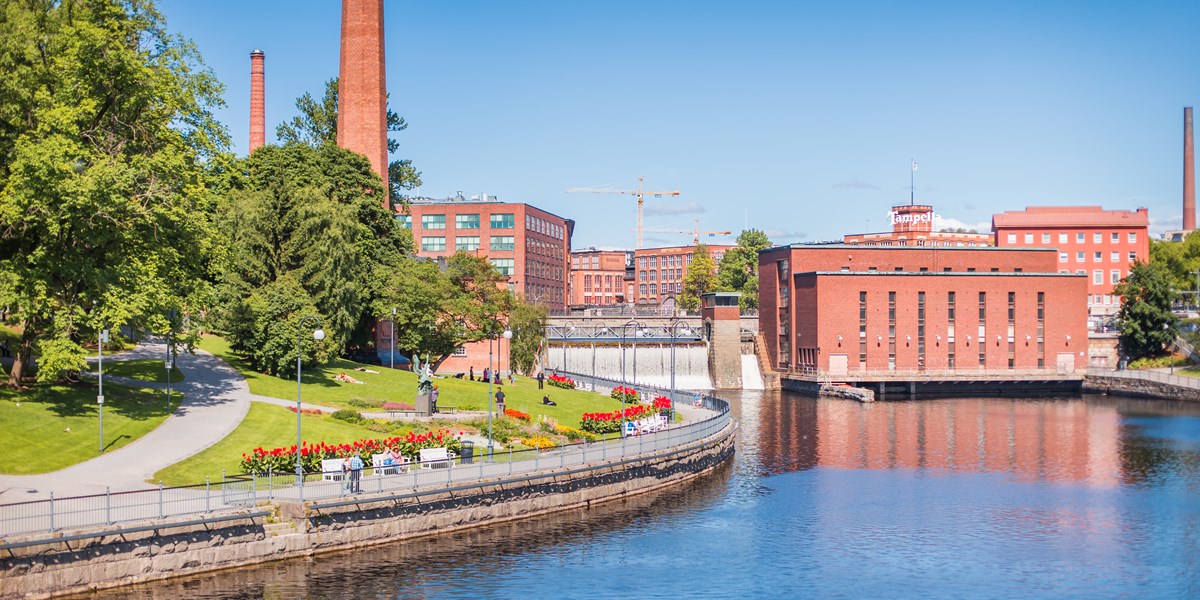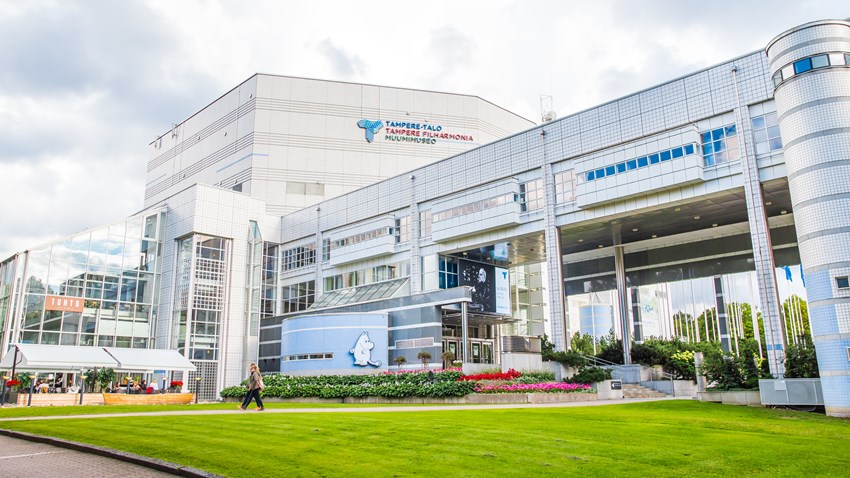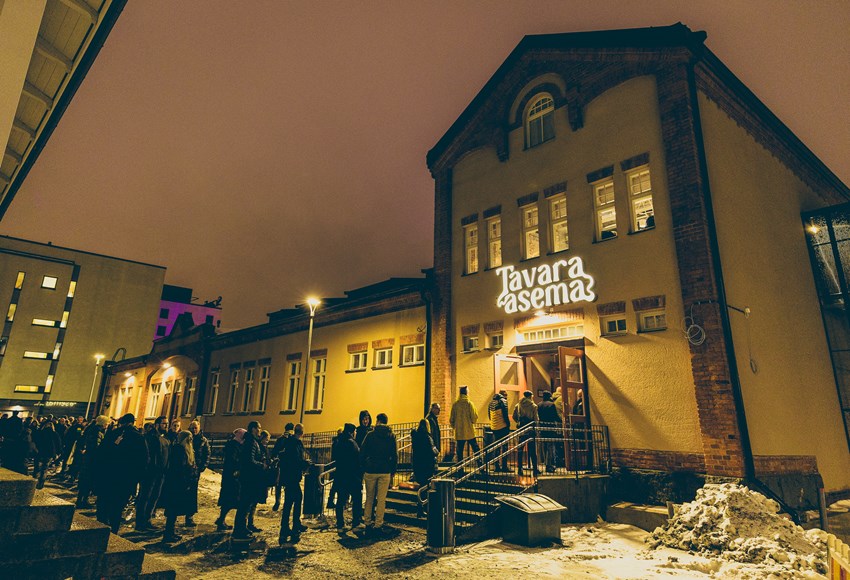Friday, June 27, 2025
Tampere: Finland’s Music Capital (Advertorial)
After Manchester last year, WOMEX (the Worldwide Music Expo) heads to Tampere, the 'Manchester of the North'. WOMEX 2025 local partner Tapio Korjus, of Rockadillo Production Oy – and a longtime resident – explains the importance of Tampere on the Finnish musical scene

Tampere (Photo by Laura Vanzo)
Tampere (pop. 260,000) is the biggest inland city in the Nordic countries and a vibrant regional capital that’s frequently described as Finland’s music capital. The city boasts the largest number of live gigs per capita in Finland and has the spectacular Tampere Hall, the largest congress centre in the Nordic countries, at its heart. It hosted WOMEX in 2019, and will be at the hub of WOMEX again this year.
Tampere is surrounded by two large lakes that give the city its distinctive air of natural peace. Lakes Näsijärvi and Pyhäjärvi have an 18m difference in water level and the Tammerkoski rapids that connect them have been an important source of power and, eventually, electricity. The industrialisation of Tampere began in 1820 when Scotsman James Finlayson founded the Finlayson textile factory. In 1882, Tampere was the first Nordic city to introduce electric lighting for general use. Due to the factories in the heart of the city, it became known as the ‘Manchester of the North’, or just ‘Manse’.
‘Manserock' refers to the Finnish language rock and pop music made in Tampere and its surrounding areas. This term was first used to market a tour by two local bands in the mid-70s, but its roots had been laid earlier. Tampere University had quite a radical image, attracting students from all over the country
One of the young people that ”a train brought to Tampere”, as the natives used to describe the newcomers, was a verbally talented guy named Juhani 'Juice' Leskinen. He began English studies at Tampere Language Institute in 1970 and, with three friends, started the band Juice Leskinen & Coitus Interruptus. Their first public performance took place at Ylioppilastalo, Tampere, and in 1973, the legendary Love Records released their first album. In 1975, Juice Leskinen & Coitus Int did a tour of the Finnish countryside dance halls together with another Tampere band, Alwari Tuohitorvi.
At that time, most Helsinki bands were singing in English, so someone came up with a title for this Finnish-language tour: ‘Manserock'! For a while, Manserock was considered a joke, but it stuck. The local bands Virtanen and Kaseva, as well as Mikko Alatalo – later a long-time MP – and the local prog rock band Tabula Rasa, are also considered pioneers of the first wave of Manserock. Punk rock gave birth to many new bands, and two of them – Eppu Normaali and Popeda – are still alive and sell out Tampere’s Ratina Stadium.

Tampere Hall (Photo by Laura Vanzo)
Juice Leskinen turned 40 on February 19, 1990. He celebrated his birthday by giving the first concert of the new Tampere Hall, which was still under construction and six months away from its official opening. Juice wrote and recorded hundreds of songs, some of them among the best-known and most-loved hits in Finland. He passed away in 2006 at the age of fifty-six. A hugely popular exhibition about Manserock is running at the Vapriikki Museum until the end of 2026.
However, there is more to music in Tampere than Manserock. There are regular concerts by Tampere Filharmonia and often big opera productions at Tampere Hall, the bi-annual Tampere Biennale and Vocal festivals, and the award-winning annual Tampere Jazz Happening. The 15,000 capacity Nokia Arena opened in 2021 and has been, for the last three years, the biggest indoor music venue in Finland. Finland’s first rock magazines Musa and Soundi were both founded in Tampere. Soundi is still being published, cementing the city's role in Finland's music world.
In the summer, Tampere has many outdoor festivals of different music genres, from small boutique indie festivals to huge EDM-focused Blockfest and the ‘crown jewel of Finland’s city festivals’: Tammerfest. Fest Afrika has been promoting African performing arts since 2002 and the Tampere chapter of Finnish Youth Association organises two annual events: the Pispala Sottiisi folk music and dance festival as well as the legendary Folklandia Cruise each January.
The club scene in town is even more diverse. The eclectic Vastavirta-klubi in Pispala attracts both hardcore punks and local hippies, and G Livelab Tampere has been winning domestic and international awards since its opening in 2019 for its quality programming and state-of-the-art audio facilities.
While Kaustinen Festival and the Sibelius Academy in Helsinki are best known globally as cornerstones of the Finnish folk music scene, nobody should underestimate the present and historical importance of the Culture and Research Archive (renamed in 2025) at Tampere University. The archive, situated at the Faculty of Social Sciences, is one of the largest folklife archives in Finland. The collections include over 20,000 hours of sound recordings and about 200,000 photographs, records, musical instruments and manuscripts. The original archive, together with the then Department of Folk Tradition, was initiated by Erkki Ala-Könni, an ethnomusicologist and researcher of Finnish folklore.
Together with Martti Pokela, Ala-Könni contributed to the revival of the (iconic Finnish traditional instrument) kantele when folk music began its resurgence in the 1960s. He was also one of the founders of the Kaustinen Folk Music Festival, and the large musical instrument collection he created was eventually moved from Tampere to Kaustinen. Hannu Saha, also a prominent figure in the Finnish folk music revival [in Kaustinen and in the Department of Folk Music in the University of Arts (Helsinki)], started his career in the Department of Folk Tradition in the 1970s. Its researchers also include ethnomusicologist Jarkko Niemi, who founded the Balkan music band Slobo Horo there with his fellow researchers in 1986. For instrumental playing, including accordion and kantele, Tampere Conservatoire has a superb reputation.

Tavara-asema (Photo by Miikka Varila)
The current crop of folk-rooted local artists include singer and composer Pelkkä Poutanen, accordionist Anne-Mari-Kivimäki (who leads her own ensemble and is a member of Suistamön Sähkö) and jouhikko (traditional bowed lyre) virtuoso Pekko Käppi whose Grateful Dead-infused band K:H:H:L keeps rocking. Pekko is also – with Laura Moisio, Kielo Kärkkäinen and Lauri Myllymäki – part of the new singer-songwriter quartet Ne Lintuizet, who are gaining momentum with their debut album and sold-out gigs.
Aside from the Expo, all daytime activities, and the two seated auditoriums in Tampere Hall, WOMEX 2025 will use several of the city’s other fine venues, including the more than 100-years-old repurposed cinema Olympia, The Torni Hotel ballroom, and the Tavara-asema, a former railroad freight station recently restored as a brand-new 1000+ capacity venue.
+ WOMEX 2025 takes place October 22–26 in Tampere: womex.com

